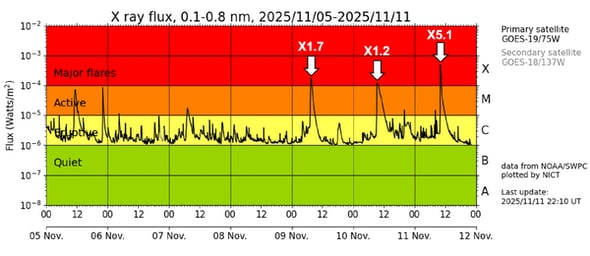
When you buy through links on our articles, Future and its syndication partners may earn a commission.

A comet discovered earlier this year continues to break apart after its close brush with the sun this month.
Astronomer Gianluca Masi of the Virtual Telescope Project captured breathtaking imagery of solar system comet C/2025 K1 (ATLAS) as its central icy core, or nucleus, appears to have broken into multiple pieces after being warmed by the sun. The comet made its closest approach to the sun on Oct. 8, and astronomers captured images following the solar flyby that appear to show it dramatically breaking apart.
These most recent images seem to confirm that, as multiple distinct fragments can be seen. The images appear to show "three fragments of the original nucleus and possibly a fourth one," Masi wrote in a statement accompanying the images.
Masi captured the images over the past week using a Celestron C14 Schmidt-Cassegrain telescope on a Paramount ME robotic mount, with a SBIG ST-10XME CCD self-guiding camera. The images consist of seven different 60-second exposures captured without any filters.

He made those exposures on five separate nights between Nov. 11 and 18 Nov. 18, and stacked them together to make an animation that depicts the motion of the fragments relative to one another:

Based on one of the images, Masi suspects the comet may have actually broken into a fourth fragment.

Astronomers at the Asiago Observatory in Italy captured the comet on Nov. 11 with the 1.82-meter Copernicus telescope, which appeared to reveal that, at that point, the comet had broken into two distinct fragments separated by about 1,200 miles (2,000 kilometers).
But even then, astronomers suspected "the presence of a third, smaller and fainter fragment to the left of the pair," Mazzotta Epifani wrote in a statement published to the Italian National Institute for Astrophysics website (translation by Google).

Like many comets, C/2025 K1 (ATLAS) is believed to have come from the Oort cloud, a distant spherical bubble of small icy bodies that surrounds our solar system at the farthest reaches of our sun's neighborhood. Many long-period comets (those that only rarely pass through the inner solar system) originate from the Oort cloud, which is thought to contain billions of small icy objects like comets (though some Oort cloud bodies are so large they qualify as dwarf planets).
Want to see these visitors from the outer solar system for yourself? Skywatchers hoping to capture their own views of distant solar system comets should check out our roundups of the best smart telescopes, cameras and lenses for astrophotography, along with our guide on how to view and photograph comets.
Editor's Note: If you would like to share your comet photos with Space.com's readers, then please send your photo(s), comments, and your name and location to [email protected].
latest_posts
- 1
 Make your choice for the treat that transports you to its nation of beginning!
Make your choice for the treat that transports you to its nation of beginning! - 2
 An Extended time of Careful Nurturing: Individual Bits of knowledge on Bringing up Youngsters
An Extended time of Careful Nurturing: Individual Bits of knowledge on Bringing up Youngsters - 3
 Share your pick for the miniature headphones that you generally suggest!
Share your pick for the miniature headphones that you generally suggest! - 4
 Find the Future of Outsourcing: Exploring the Gig Economy
Find the Future of Outsourcing: Exploring the Gig Economy - 5
 NICT、「太陽フレア」で注意喚起 X5.1など複数回の大規模な爆発を観測(ITmedia NEWS)
NICT、「太陽フレア」で注意喚起 X5.1など複数回の大規模な爆発を観測(ITmedia NEWS)
 6 Solid Vehicle Fix Administrations to Keep Your Vehicle in Prime Condition
6 Solid Vehicle Fix Administrations to Keep Your Vehicle in Prime Condition Simple Consideration Plants for Home and Office: An Aide
Simple Consideration Plants for Home and Office: An Aide VPN Administrations for Online Protection
VPN Administrations for Online Protection Internet Bookkeeping Programming for Consultants
Internet Bookkeeping Programming for Consultants Relentless rise in carbon pollution from fossil fuels slightly dampens climate-fighting hopes
Relentless rise in carbon pollution from fossil fuels slightly dampens climate-fighting hopes Shah Capital pushes for Novavax sale, warns of proxy fight
Shah Capital pushes for Novavax sale, warns of proxy fight セブン、店内“スチーム”調理の「できたてラーメン」 600円前後で発売、勝機は?(ITmedia ビジネスオンライン)
セブン、店内“スチーム”調理の「できたてラーメン」 600円前後で発売、勝機は?(ITmedia ビジネスオンライン) 楽天・辰己涼介が国内FA権行使表明「総合的に判断して伝えました」メジャー挑戦は「諦めたわけではなく」も「楽天含めて必要としてくれるチームがあるか」(デイリースポーツ)
楽天・辰己涼介が国内FA権行使表明「総合的に判断して伝えました」メジャー挑戦は「諦めたわけではなく」も「楽天含めて必要としてくれるチームがあるか」(デイリースポーツ) 年金運用14.4兆円黒字 7~9月期(共同通信)
年金運用14.4兆円黒字 7~9月期(共同通信)













